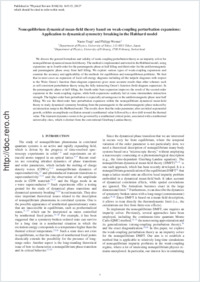Nonequilibrium dynamical mean-field theory based on weak-coupling perturbation expansions: Application to dynamical symmetry breaking in the Hubbard model
- Tsuji, Naoto Department of Physics, University of Tokyo, Japan
- Werner, Philipp Department of Physics, University of Fribourg, Switzerland
-
09.10.2013
Published in:
- Physical Review B. - 2013, vol. 88, no. 16, p. 165115
English
We discuss the general formalism and validity of weak-coupling perturbation theory as an impurity solver for nonequilibrium dynamical mean-field theory. The method is implemented and tested in the Hubbard model, using expansions up to fourth order for the paramagnetic phase at half filling and third order for the antiferromagnetic and paramagnetic phase away from half filling. We explore various types of weak-coupling expansions and examine the accuracy and applicability of the methods for equilibrium and nonequilibrium problems. We find that in most cases an expansion of local self-energy diagrams including all the tadpole diagrams with respect to the Weiss Green's function (bare-diagram expansion) gives more accurate results than other schemes such as self-consistent perturbation theory using the fully interacting Green's function (bold-diagram expansion). In the paramagnetic phase at half filling, the fourth-order bare expansion improves the result of the second-order expansion in the weak-coupling regime, while both expansions suddenly fail at some intermediate interaction strength. The higher-order bare perturbation is especially advantageous in the antiferromagnetic phase near half filling. We use the third-order bare perturbation expansion within the nonequilibrium dynamical mean-field theory to study dynamical symmetry breaking from the paramagnetic to the antiferromagnetic phase induced by an interaction ramp in the Hubbard model. The results show that the order parameter, after an initial exponential growth, exhibits an amplitude oscillation around a nonthermal value followed by a slow drift toward the thermal value. The transient dynamics seems to be governed by a nonthermal critical point, associated with a nonthermal universality class, which is distinct from the conventional Ginzburg-Landau theory.
- Faculty
- Faculté des sciences et de médecine
- Department
- Département de Physique
- Language
-
- English
- Classification
- Physics
- License
-
License undefined
- Identifiers
-
- RERO DOC 208665
- DOI 10.1103/PhysRevB.88.165115
- Persistent URL
- https://folia.unifr.ch/unifr/documents/303341
Statistics
Document views: 96
File downloads:
- pdf: 277
